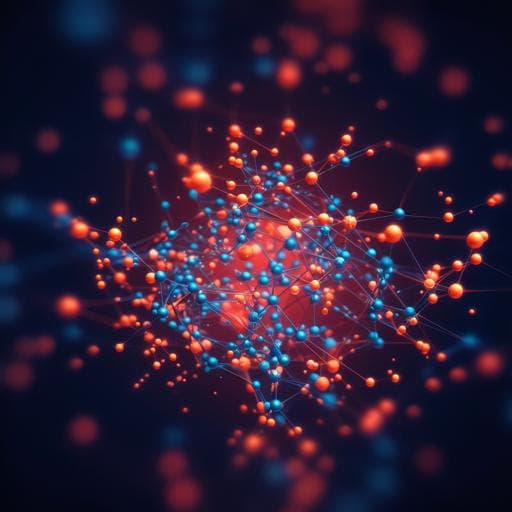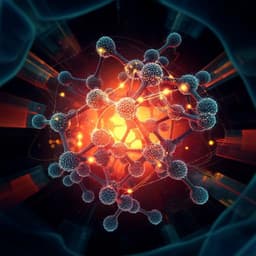
Chemistry
Imaging 3D chemistry at 1 nm resolution with fused multi-modal electron tomography
J. Schwartz, Z. W. Di, et al.
Discover how a team of researchers led by Jonathan Schwartz has tackled the challenge of mapping chemistry in nanoscale materials. Their groundbreaking work introduces fused multi-modal electron tomography, achieving unprecedented high-resolution 3D chemical mapping. This innovative technique promises to revolutionize our understanding of various nanomaterials by providing sub-nanometer resolution even at low electron doses.
~3 min • Beginner • English
Introduction
The study addresses the central challenge of mapping 3D chemical distributions in nanoscale materials without incurring prohibitive electron doses that damage beam-sensitive specimens. Traditional chemical tomography using EELS/EDX requires high electron doses (often >10⁷ e⁻/Ų), forcing researchers to collect only a few projections at low dose and accept low resolution and noisy reconstructions. A paradigm shift is needed to obtain high-resolution 3D chemical maps under dose constraints. The authors propose exploiting complementary information inherent to elastic (HAADF-STEM) and inelastic (EELS/EDX) signals, and moving beyond simple correlation to multi-modal data fusion to reconstruct chemically specific 3D information at low dose. They extend a fused multi-modal electron microscopy framework from 2D to 3D tomography, aiming to achieve ~1 nm or better 3D chemical resolution at orders-of-magnitude lower dose than conventional chemical tomography.
Literature Review
Electron tomography provides high-resolution 3D structural information from elastic scattering but lacks chemical specificity. Early demonstrations of chemical tomography with EELS/EDX provided milestones but required doses that exceed specimen limits, restricting applicability and resolution. Prior approaches to combine modalities have included correlative imaging and bimodal reconstructions (e.g., HAADF with EDX/EELS), as well as total generalized variation and cross-modal fusion methods. Recent 2D multi-modal data fusion incorporating non-linear Rutherford scattering physics significantly reduced dose requirements for atomic-resolution maps. Building on these, the present work generalizes multi-modal fusion to 3D tomography, leveraging joint regularization and forward models for both HAADF and spectroscopic modalities to mitigate undersampling and noise at low dose.
Methodology
Fused multi-modal electron tomography jointly reconstructs 3D chemical distributions by integrating high-SNR structural information from HAADF-STEM with sparsely sampled chemically specific EELS/EDX projections. The reconstruction solves an inverse problem with a cost function that enforces consistency with HAADF and chemical measurements and includes total variation (TV) regularization to promote piecewise-smooth solutions while preserving edges. An example optimization form is: minimize over x the sum of modality data-fidelity terms and λ-weighted isotropic TV penalties, with non-negativity constraints. The HAADF forward model assumes an incoherent linear imaging approximation with Z-dependent scattering (scaling roughly between Z³–Z⁴), while spectroscopic measurements are modeled with appropriate statistics (Poisson log-likelihood or least-squares in higher count regimes). Weights (λ) balance data fidelity and regularization, chosen to ensure convergence and accurate recovery; step sizes can be set via estimates of the Lipschitz constant (e.g., Power method). A primal-dual algorithm with TV proximal operators is used; initialization employs reconstructions from raw measurements. Multi-modal tilt series are acquired with many HAADF projections and sparse chemical maps. Example acquisitions: Au–Fe₂O₃ on a Talos F200X G2 at 200 kV, HAADF from −60° to +60° in 3° steps, EELS every 15° with millisecond dwell; Co₃O₄–MnO₄ on an aberration-corrected Titan 80–300 at 300 kV with rapid dual-disk EELS sampling; Cu–SiC on a Talos F200X G2 with HAADF −75° to +30° in 3° steps and sparse EELS. Tilt series alignment uses background subtraction, survey-image referencing, coarse alignment via CoM or cross-correlation (depending on specimen isolation), and fine alignment by projection matching on HAADF, applying the derived shifts to the chemical projections. Simulations employ multi-channel phantoms (e.g., CuO, CoO, Au) with incoherent linear models, Poisson noise, and limited tilt ranges (±70°) to match experimental conditions. Bayesian optimization (Gaussian process regression with Matérn kernel and hedging acquisition) efficiently explores hyperparameters over large grids, accelerated with asynchronous parallel GPU computing to generate NRMSE maps and SNR analyses.
Key Findings
- Achieved sub-nanometer 3D chemical resolution in Au–Fe₃O₄ nanoparticle superlattices, with real-space half-pitch resolution of approximately 0.8 nm × 0.8 nm × 1.1 nm (x, y, z). Along optimized directions, resolution approaches the Nyquist limit (~0.805 nm).
- Demonstrated that fusing many HAADF projections (e.g., 50–180) with few chemical projections (e.g., 5–15) yields high-quality 3D chemical reconstructions at drastically reduced electron dose (roughly 100-fold lower than conventional chemical tomography).
- In simulations of synthetic CoO/CuO/Au systems with ±70° tilt, fused multi-modal tomography reduced reconstruction error: NRMSE improved from ~1.301 (conventional chemical tomography) to ~0.33 (fused). Across parameter sweeps, average NRMSE in the fused regime can be <0.040, substantially outperforming conventional approaches.
- Compared to traditional methods, achieving equivalent resolution would require ~45 EELS maps and substantially higher per-projection SNR, implying up to ~20× more dose; fused reconstructions attain similar or better performance at ~1/100 the total dose.
- Enabled 3D chemical mapping at doses as low as ~10 e⁻/Ų and validated across multiple materials: Au–Fe₂O₃ superlattice clusters, Co₃O₄–Mn₃O₄ core–shell nanocrystals, ZnS–Cu₂O₆.5–3O₄ and ZnS–Cu₂O heterostructures, and Cu–SiC catalysts.
- Provided chemically specific insights such as Mn shell coverage and interfacial strand growth on Co₃O₄ cores; distinguished similar phases (e.g., ZnS vs. Cd₉S₁₁O₃) and identified embedded Cu nanoparticles in SiC.
- Fused modality establishes that the HAADF 3D resolution provides an upper bound on attainable chemical resolution; observed ~25% resolution reduction along the missing-wedge direction in incomplete tilt ranges.
Discussion
The fused multi-modal framework directly addresses the central limitation of chemical tomography—dose- and sampling-limited acquisition—by integrating high-SNR structural HAADF data with sparse, chemically specific EELS/EDX measurements within a joint reconstruction. This fusion makes the otherwise underdetermined chemical tomography problem identifiable, transferring high-resolution spatial information from HAADF to the chemical channels while preserving chemical specificity. The outcome is chemically resolved 3D reconstructions at or below ~1 nm resolution with orders-of-magnitude lower dose, expanding applicability to beam-sensitive and compositionally complex materials. Simulations and experiments demonstrate significant error reduction (NRMSE) and SNR improvements over conventional chemical tomography, confirming the method’s robustness across modalities, sampling regimes, and materials. While the HAADF resolution sets an upper limit and incomplete tilt ranges introduce anisotropy (missing-wedge), the fused approach still delivers near-HAADF resolution in chemistry, enabling quantitative analyses such as shell thickness, interfacial chemistry, and local stoichiometry without precise elastic cross-section knowledge.
Conclusion
This work introduces fused multi-modal electron tomography for 3D chemical imaging at sub-nanometer resolution and drastically reduced electron dose by jointly reconstructing HAADF and EELS/EDX data with TV regularization. The method achieves ~0.8–1.1 nm resolution, reduces dose requirements by ~100× relative to conventional chemical tomography, and generalizes across diverse nanomaterial systems. It enables detailed 3D chemical insights, including interfacial structures and stoichiometry, previously inaccessible due to radiation damage and undersampling. Future research directions include mitigating missing-wedge anisotropy via extended tilt geometries (e.g., needle geometries, full ±90°), integrating additional modalities (e.g., ABF, ptychography), optimizing adaptive sampling strategies, extending to dynamic and in situ studies, and further automating hyperparameter selection and alignment with machine learning and advanced optimization.
Limitations
- Incomplete tilt ranges introduce a missing wedge that reduces resolution anisotropically; an ~25% reduction is observed along the missing-wedge direction.
- Chemical resolution is ultimately bounded by the attainable HAADF 3D resolution and quality of alignment between modalities.
- The underdetermined nature of sparse chemical projections requires careful regularization and weighting; suboptimal parameters slow convergence or reduce fidelity.
- Reconstruction quality depends on accurate multi-modal alignment and background subtraction; complex fields of view with multiple particles may complicate coarse alignment.
- While stoichiometry can be inferred from voxel-wise ratios, absolute quantification may still be influenced by noise floors and model approximations in forward imaging physics.
Related Publications
Explore these studies to deepen your understanding of the subject.







